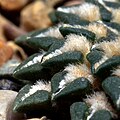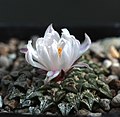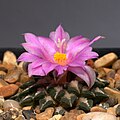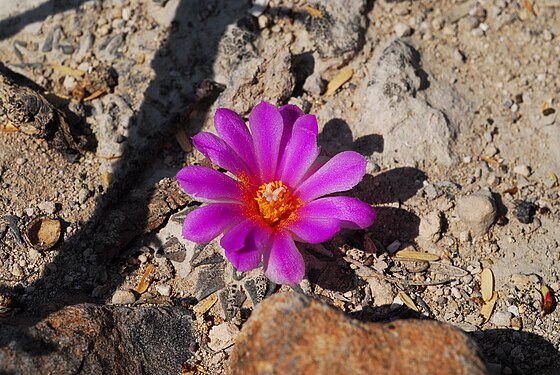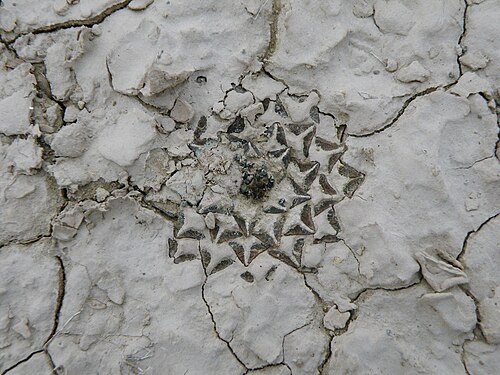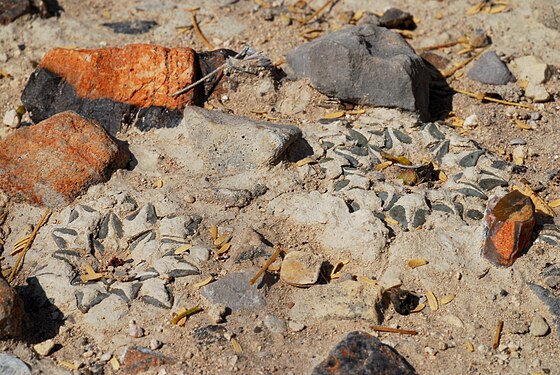Ariocarpus kotschoubeyanus
| Ariocarpus kotschoubeyanus | |
|---|---|

| |
| Scientific classification | |
| Kingdom: | Plantae |
| Clade: | Tracheophytes |
| Clade: | Angiosperms |
| Clade: | Eudicots |
| Order: | Caryophyllales |
| Family: | Cactaceae |
| Subfamily: | Cactoideae |
| Genus: | Ariocarpus |
| Species: | A. kotschoubeyanus
|
| Binomial name | |
| Ariocarpus kotschoubeyanus (Lem.) K.Schum.
| |
| Synonyms | |
|
List
| |
Ariocarpus kotschoubeyanus is a species of plant in the family Cactaceae.
Description
[edit]The Ariocarpus koschoubeyanus usually grows alone and remains below the soil surface. Its dark olive-green shoots, which are flattened at the tip and slightly sunken in the middle, have a diameter of 3 to 7 cm (1.2 to 2.8 in). The warts are spirally arranged, elongated at the base, becoming broadly triangular and tapering towards the tip. They measure 5 to 13 mm (0.20 to 0.51 in) long and 3 to 10 mm (0.12 to 0.39 in) wide. A woolly furrow extends across the middle of the areoles, and there are no thorns.
The flowers are typically crimson red and 1.5 to 2.5 cm (0.59 to 0.98 in) in diameter, though there is at least one population with white flowers. The sepals are green or brownish, somewhat fleshy, and often split into two columns. The petals are lanceolate-spatulate, pointed, blunt, or edged. The stamens, style, and stigma are white. The elongated fruits are 8 to 18 mm (0.31 to 0.71 in) long.[3]
-
Close up on flower
-
Leaves
-
White flower form
-
Pink flower form
Distribution
[edit]The distribution of Ariocarpus koschoubeyanus ranges from the Mexican state of Coahuila south to Querétaro, including parts of Zacatecas, San Luis Potosí, Nuevo León, and Tamaulipas, where it grows in the Chihuahuan Desert in loamy plains growing at elevations of 1000 to 1900 meters. It is threatened by habitat loss. Plants are found growing along Dasylirion longissimum, Thelocactus bicolor, Mammillaria elongata, Agave stricta, Lophophora williamsii, Ferocactus uncinatus , and Echinocereus schmollii. [4]
-
Plant growing in Nuevo Leon, Mexico
-
Plant growing in Estacion Marte,Coahuila
-
Plant growing near Dr. Arroyo, Nuevo Leon, Mexico
Taxonomy
[edit]The species was first collected around 1840 by Wilhelm Friedrich von Karwinsky and sent to Europe. Charles Lemaire described it in 1842 as Anhalonium kotschoubeyanum.[5] The specific epithet honors Prince Wassili Viktorovich Kochubey. Karl Moritz Schumann reassigned the species to the genus Ariocarpus in 1898.
Pharmacology
[edit]Hordenine and N-methyltyramine were found in Ariocarpus kotschoubeyanus.[6]
References
[edit]- ^ Gómez-Hinostrosa, C.; Sotomayor, M.; Hernández, H.M.; Smith, M. (2017). "Ariocarpus kotschoubeyanus". IUCN Red List of Threatened Species. 2017: e.T41217A121435216. doi:10.2305/IUCN.UK.2017-3.RLTS.T41217A121435216.en. Retrieved 16 November 2021.
- ^ "Appendices | CITES". cites.org. Retrieved 2022-01-14.
- ^ Anderson, Edward F.; Eggli, Urs (2005). Das grosse Kakteen-Lexikon (in German). Stuttgart (Hohenheim): Ulmer. pp. 73–74. ISBN 3-8001-4573-1.
- ^ Vallicelli, Valentino (2013-08-04). "Ariocarpus kotschoubeyanus". LLIFLE. Retrieved 2024-06-14.
- ^ Engler, Adolf (1898). Botanische Jahrbücher fur Systematik, Pflanzengeschichte und Pflanzengeographie. Vol. Bd.24 (1898). Schweizerbart [etc.] ISSN 0006-8152. Retrieved 2024-06-14.
- ^ Neal, J.M.; Sato, P.T.; Johnson, C.L.; McLaughlin, J.L. (1971). "Cactus Alkaloids X: Isolation of Hordenine and N-Methyltyramine from Ariocarpus kotschoubeyanus". Journal of Pharmaceutical Sciences. 60 (3): 477–478. doi:10.1002/jps.2600600334. PMID 5572136.
External links
[edit] Media related to Ariocarpus kotschoubeyanus at Wikimedia Commons
Media related to Ariocarpus kotschoubeyanus at Wikimedia Commons Data related to Ariocarpus kotschoubeyanus at Wikispecies
Data related to Ariocarpus kotschoubeyanus at Wikispecies



